

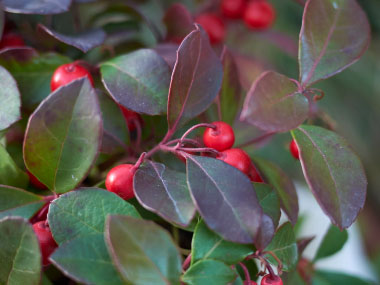
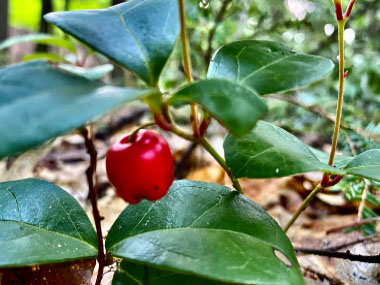
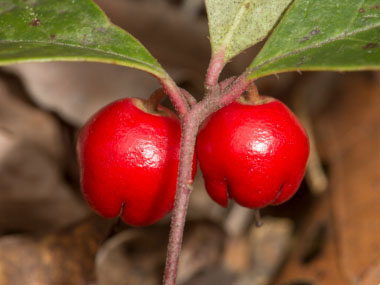
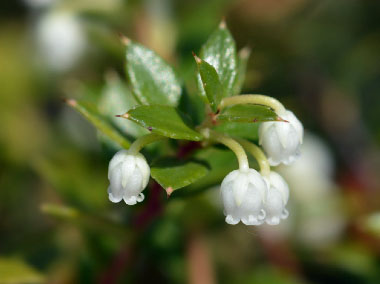
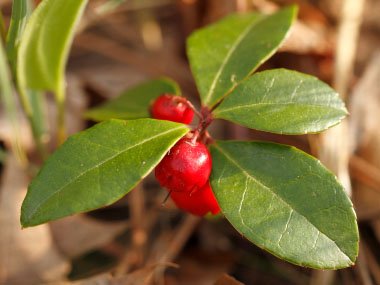
To support our efforts please browse our store (books with medicinal info, etc.).
Wintergreen is a low-growing, spreading, rhizomatous shrub with shiny, evergreen leaves. It is a member of the Ericaceae (heath) family, a large family of flowering plants usually found in acid soil. Wintergreen is part of the Gaultheria genus. This genus was named after Jean-François Gaultier, a naturalist and physician in Quebec in the mid-18th century. It bears small white flowers followed by bright red berries that often persist through winter. Other common names include American Wintergreen, Teaberry, Eastern Teaberry, Creeping Wintergreen, Deerberry, Mountain Tea, Redberry Wintergreen, and Spiceberry. Wintergreen was once used as a tasty tea and for medicinal uses among the Algonquin, Cherokee, Chippewa, and Iroquois.
Trunk/Bark
Bark is smooth, and either green or red.
Branches/Twigs
Stems are slender and woody, sparsely hairy, creeping above ground or subterranean, rooting down and sending up periodic upright branches to form colonies.
Height
This is a spreading low shrub that can grow from 5 to 20cm ( 3 to 8") tall.
Leaves/Needles
Alternate leaves occur along the stems. Leaves measure 2 to 5cm ( 3/4 to 2") long and about one-third to one-half as much across. They are elliptic, and ovate or oval in shape. The margins of the leaves are sparsely serrated with bristly teeth. The upper leaf surface is medium to dark green, hairless, and shiny. The lower leaf surface is light green, hairless and dull. Leaf texture is somewhat stiff and leathery. Wintergreen leaves have a minty (or wintergreen) fragrance, especially when crushed. The evergreen foliage becomes reddish or purplish during the autumn.
Flowers
White flowers measure about 8mm (1/3") in length. Each flower is radially symmetrical. There are five petals, sepals, or tepals in the flower. The petals or the sepals are fused into a cup or tube.
Fruit
The ripe fruit is red, fleshy, and measures 7 to 10mm (about 1/3") in length.
Habitat
As long as the soil is acidic, wintergreen grows well on many substrates including peat, sand, and sandy loam. It is commonly found in the understory of pine trees but can grow in hardwood forests as well.
Edible Parts
The flavor of wintergreen comes from methyl salicylate, a chemical related to the active ingredient in aspirin. People with aspirin allergies should not consume wintergreen. The berry can be consumed raw or cooked. Best consumed after a frost. The fruit tends to stay on the plant until spring if it is not eaten by birds or other wildlife. The fruits can be used in pies, or made into jams etc. Young leaves can be nibbled on raw but a nice tea can be made from fresh leaves. A strong tea can be made by fermenting the bright red leaves.
Other Name
Eastern Teaberry.
Recipes
Winter Survival Food Handbook

PDF Plant Magazines
Types of Wild Food
Geographic Zones Seasons
Disclaimer
EdibleWildFood.com is informational in nature. While we strive to be 100% accurate, it is solely up to the reader to ensure proper plant identification. Some wild plants are poisonous or can have serious adverse health effects.
We are not health professionals, medical doctors, nor are we nutritionists. It is up to the reader to verify nutritional information and health benefits with qualified professionals for all edible plants listed in this web site. Please click here for more information.
Why Edible Wild Food?
- Food costs are rising
- Free, wild food is readily abundant
- Wild food adds nutrition to your diet
- Wild food can help treat various medical conditions





